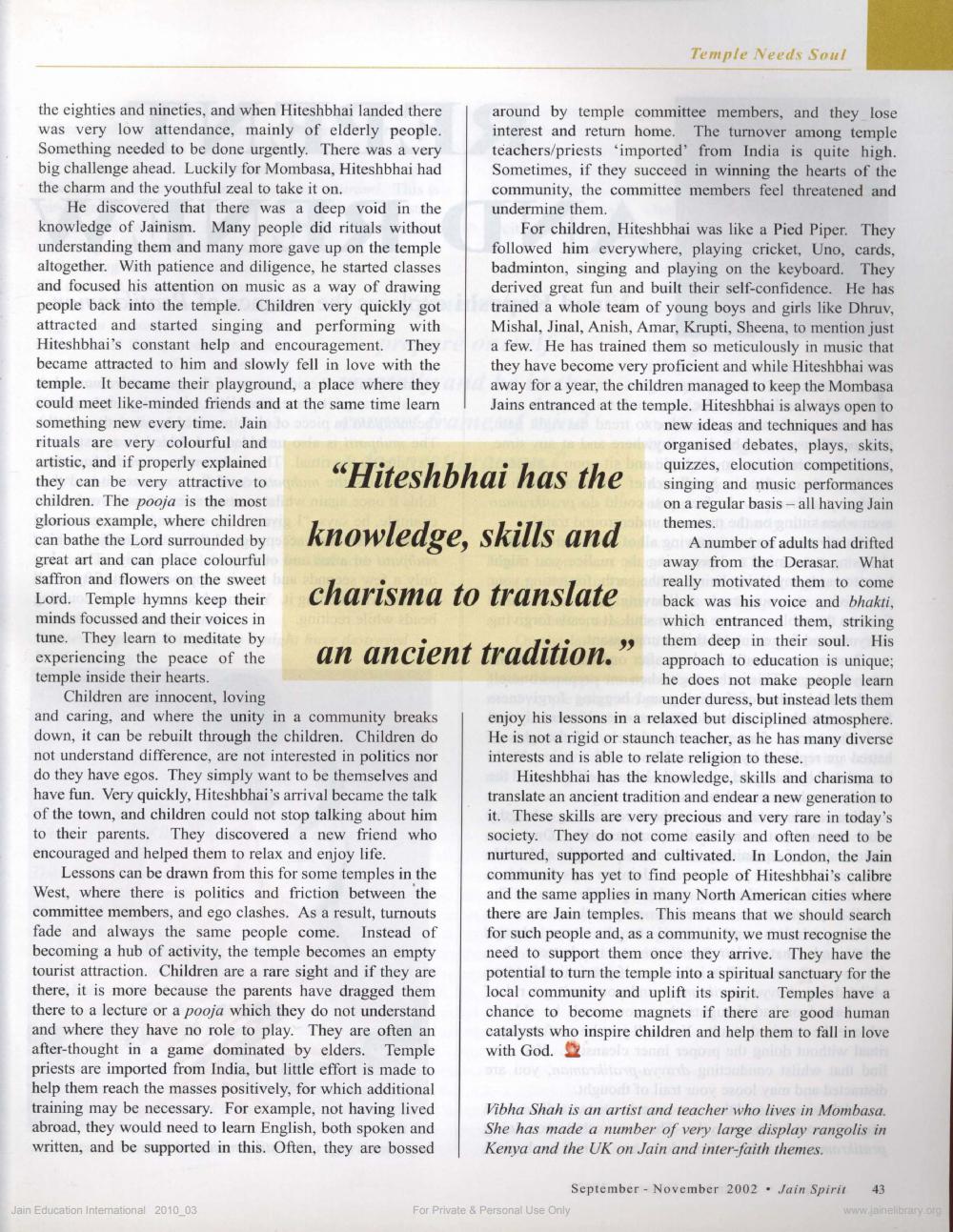________________
Temple Needs Soul
the eighties and nineties, and when Hiteshbhai landed there was very low attendance, mainly of elderly people. Something needed to be done urgently. There was a very big challenge ahead. Luckily for Mombasa, Hiteshbhai had the charm and the youthful zeal to take it on.
He discovered that there was a deep void in the knowledge of Jainism. Many people did rituals without understanding them and many more gave up on the temple altogether. With patience and diligence, he started classes and focused his attention on music as a way of drawing people back into the temple. Children very quickly got attracted and started singing and performing with Hiteshbhai's constant help and encouragement. They became attracted to him and slowly fell in love with the temple. It became their playground, a place where they could meet like-minded friends and at the same time learn something new every time. Jain rituals are very colourful and artistic, and if properly explained they can be very attractive to children. The pooja is the most glorious example, where children can bathe the Lord surrounded by great art and can place colourful saffron and flowers on the sweet Lord. Temple hymns keep their minds focussed and their voices in tune. They learn to meditate by experiencing the peace of the temple inside their hearts.
Children are innocent, loving and caring, and where the unity in a community breaks down, it can be rebuilt through the children. Children do not understand difference, are not interested in politics nor do they have egos. They simply want to be themselves and have fun. Very quickly, Hiteshbhai's arrival became the talk of the town, and children could not stop talking about him to their parents. They discovered a new friend who encouraged and helped them to relax and enjoy life.
Lessons can be drawn from this for some temples in the West, where there is politics and friction between the committee members, and ego clashes. As a result, turnouts fade and always the same people come. Instead of becoming a hub of activity, the temple becomes an empty tourist attraction. Children are a rare sight and if they are there, it is more because the parents have dragged them there to a lecture or a pooja which they do not understand and where they have no role to play. They are often an after-thought in a game dominated by elders. Temple priests are imported from India, but little effort is made to help them reach the masses positively, for which additional training may be necessary. For example, not having lived abroad, they would need to learn English, both spoken and written, and be supported in this. Often, they are bossed
"Hiteshbhai has the knowledge, skills and charisma to translate an ancient tradition.”
around by temple committee members, and they lose interest and return home. The turnover among temple teachers/priests 'imported from India is quite high. Sometimes, if they succeed in winning the hearts of the community, the committee members feel threatened and undermine them.
For children, Hiteshbhai was like a Pied Piper. They followed him everywhere, playing cricket, Uno, cards, badminton, singing and playing on the keyboard. They derived great fun and built their self-confidence. He has trained a whole team of young boys and girls like Dhruv, Mishal, Jinal, Anish, Amar, Krupti, Sheena, to mention just a few. He has trained them so meticulously in music that they have become very proficient and while Hiteshbhai was away for a year, the children managed to keep the Mombasa Jains entranced at the temple. Hiteshbhai is always open to
new ideas and techniques and has organised debates, plays, skits, quizzes, elocution competitions, singing and music performances on a regular basis-all having Jain themes.
A number of adults had drifted away from the Derasar. What really motivated them to come back was his voice and bhakti, which entranced them, striking them deep in their soul. His approach to education is unique; he does not make people learn
under duress, but instead lets them enjoy his lessons in a relaxed but disciplined atmosphere. He is not a rigid or staunch teacher, as he has many diverse interests and is able to relate religion to these.
Hiteshbhai has the knowledge, skills and charisma to translate an ancient tradition and endear a new generation to it. These skills are very precious and very rare in today's society. They do not come easily and often need to be nurtured, supported and cultivated. In London, the Jain community has yet to find people of Hiteshbhai's calibre and the same applies in many North American cities where there are Jain temples. This means that we should search for such people and, as a community, we must recognise the need to support them once they arrive. They have the potential to turn the temple into a spiritual sanctuary for the local community and uplift its spirit. Temples have a chance to become magnets if there are good human catalysts who inspire children and help them to fall in love with God.
Vibha Shah is an artist and teacher who lives in Mombasa. She has made a number of very large display rangolis in Kenya and the UK on Jain and inter-faith themes.
September - November 2002 . Jain Spirit 43 For Private & Personal Use Only
www.ainelibrary ste
Jain Education International 2010_03




